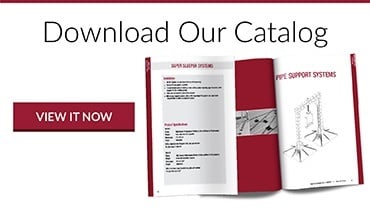It's difficult to predict when extreme weather events may strike and how they may impact commercial or industrial activity in an area. One example of such was seen in 2019 when hurricanes and winds caused significant damage in several parts of the US, and wind speeds reached as high as 90 mph in parts of Massachusetts.
Not only can such extreme weather activity pose a significant risk to your roofing and other parts of your commercial/industrial structure, especially if it's smashing debris against the structure, but it can also be severely damaging to your equipment, pipelines, and other structures on the roof. One way to prevent or at least mitigate this damage is to raise the wind-resistance profile of your structures/buildings with high-resilience rooftop supports.
How Wind Impacts Rooftop Equipment and Structures
Strong winds can impact your rooftop elements (equipment, structures, pipelines, etc.) and your roofing in both the short-term and long-term.
The long-term impact is the stress strong wind may put on your equipment and its anchoring over time. If the anchoring is rooted in the roofing membrane, some of the impacts may be transferred to the roofing itself, and while it disperses the impact over a larger area, it may not be healthy from a roofing integrity and durability perspective.
Then, there is the shorter-term impact of high winds, especially during extreme events. A hurricane wind moving at an extremely high speed can hit your rooftop equipment with a strong enough force to cause them to break away (if they are inappropriately tethered) or damage them directly via strong movement. Strong winds can damage pipelines and conduits by stressing out joints and other vulnerable points across their lengths.
That's not taking into account other factors that may exacerbate the situation, like the extreme cold that can make the metal more brittle, which may make thin/weak pipelines more vulnerable.
The Solution: High-Resilience Rooftop Supports
It’s important to understand that high-resilience rooftop support may offer resilience and protection (to your rooftop equipment and pipes) against a wide range of environmental elements, including but not limited to strong winds.
But if we limit ourselves to the strong winds and their long-term and short-term impact on rooftop equipment, pipes, and channels, high-resilience rooftop supports can be considered a viable solution since they provide adequate anchorage to the equipment, pipelines, and conduit. These high-resilience rooftop supports can take on most of the load/stress the winds put on the rooftop structures and distribute/disperse it on the roofing equally, without causing undue shear forces on specific parts of the roofs, as is common with improper rooftop supports. Most of these supports are placed evenly, which also contributes to the structural integrity of spread-out rooftop structures like pipelines, conduits, and HVAC ducts and may have additional fastenings installed for adequate wind resistance.
The bases of these rooftop supports also play an important part when it comes to wind resistance. For low to moderate wind resistance, support bases anchored by weights may be enough, but in high-wind areas and conditions, these supports have to be attached to a base/deck. They can be attached to the roofing itself, but this way, it becomes a penetrative rooftop support solution that may compromise the roofing integrity, especially in high-wind conditions.
Zero penetration high-resilience rooftop supports also offer better wind resistance (when compared to penetrative supports) to the roofing as well, as they do not compromise the structural integrity of the roof itself.
It’s important to understand that not all high-resilience rooftop supports may be designed and manufactured in the same way. Even if we consider the dimension of wind resistance, some high-resilience rooftop supports may have lower tolerances (as individual supports and entire systems) compared to others. While the ones designed and manufactured for areas where high wind activity is common, the tolerances may have to be adjusted accordingly. The supports may also have to be modified based on the load they are designed to bear and other extreme environmental conditions like extreme cold and heat.
Choosing The Right Manufacturer For High-Resilience Rooftop Support
Every business and commercial/industrial entity may have different rooftop support requirements based on the equipment and pipelines on their rooftop, and when you add wind resistance requirements to the equation, they become more challenging to tackle and navigate. That's where rooftop support manufacturers like PHP Systems/Design come into play. We are pioneers in zero-penetration rooftop support with extensive experience when it comes to designing and manufacturing rooftop supports may come into play. We can manufacture high-resilience rooftop supports and systems that may be a perfect match for your particular wind resistance requirements.



